The art of teaching in an unfamiliar ecosystem

In the middle of May, I moved halfway across the country, to a state I’d never been to, to play at a wetland with five- and six-year-olds. After three long days in a car, I landed in Boulder, Colorado. I moved into my tiny studio apartment across the street from Colorado University, and jumped into training with the folks at Thorne Nature Experience.
Now, I’m going to tell you a secret. Though I’ve taught and been involved with Environmental Education for the past six years, I’ve only worked for one organization. North Cascades Institute had been my home as far back as I can remember, and when I realized that I wanted to try my hand at teaching, it was a logical place to start. And then I stayed. I used to joke that I’d never leave. And that was true until I finished the M.Ed program through North Cascades Institute and Western Washington University this past March. I decided it was time, though I was (and still am) deeply rooted in the Pacific Northwest, to get some experience elsewhere.
Elsewhere, it turned out, was a city with 300 or so sunny days every year. (I’m really more of a rain person.) Thorne is a pretty cool place. They’ve been around since 1954 and are located on a beautiful piece of “open space” land just east of Boulder proper called Sombrero Marsh.
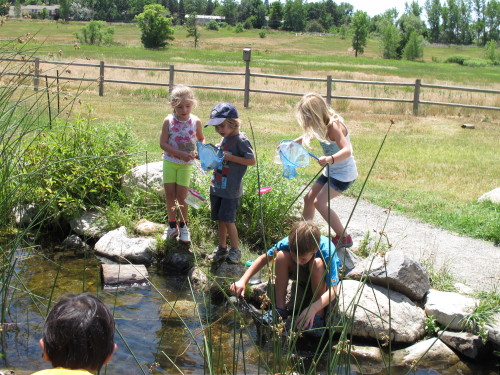 “Come look, I found something! It’s in my net!”
“Come look, I found something! It’s in my net!”
 No nature center is complete without plenty of dip nets for catching macroinvertebrates! Most commonly we find damselfly larvae, although early in the summer we found quite a few dragonfly nymphs and on one field trip a huge bullfrog tadpole!
No nature center is complete without plenty of dip nets for catching macroinvertebrates! Most commonly we find damselfly larvae, although early in the summer we found quite a few dragonfly nymphs and on one field trip a huge bullfrog tadpole!
I was a little nervous about moving to a city that sits higher than 5,000 ft, after living for my entire 27 years at or within 1,500 ft of sea level. But where Bellingham has hills all over town, Boulder is flat. My commute to work is 4 ½ miles and I can bike there no problem in about 30 minutes, half of it on the Boulder Creek Path that runs east-west all the way through town.
But y’all really want to know about the littles, right? My five- and six-year-old students? Well they’re adorable. In the beginning I wasn’t exactly sure what they could do. I’d worked in a daycare in college, and then with 5th-12th graders and adults at North Cascades Institute. So where do kindergarten and first graders fit? How developed are their brains and their motor skills? What about their attention spans? I came to Thorne with all this experience in the outdoors, confident that I knew lessons, games, and activities for any subject they could throw at me. But the more I thought about this new age group, the more I wondered if my arsenal of tools and materials would work.
What I discovered is that I had a lot of learning to do, even though I could easily adapt some lessons and activities for this new age group. All through nine weeks of summer camp I had keep reminding myself that they weren’t fifth graders. I had to add in time for things like tying shoes and helping apply sunscreen and bug spray.
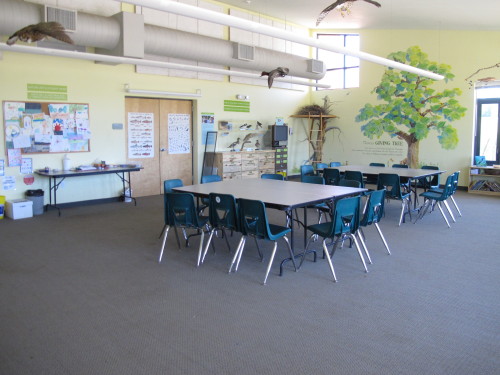 I had to get used to doing some teaching in a classroom, having spent all my previous teaching on trails and in outdoor shelters when it rained. But since there’s no trees at the marsh to provide shade, we go back and forth between the air conditioned classroom and the incredible heat outside.
I had to get used to doing some teaching in a classroom, having spent all my previous teaching on trails and in outdoor shelters when it rained. But since there’s no trees at the marsh to provide shade, we go back and forth between the air conditioned classroom and the incredible heat outside.
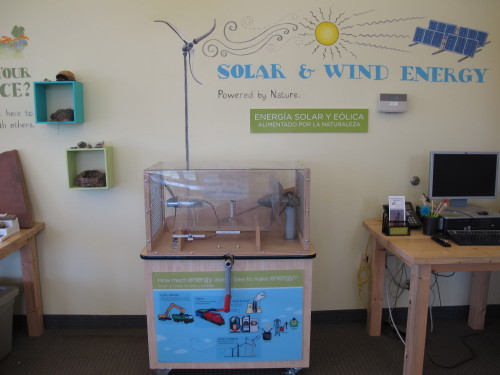 About 14% of Colorado’s electricity comes from wind turbines. This miniature one in our classroom lets the kids see how it works and try their hand at generating some of their own wind-powered electricity as they turn the big red handle to start up the propellers.
About 14% of Colorado’s electricity comes from wind turbines. This miniature one in our classroom lets the kids see how it works and try their hand at generating some of their own wind-powered electricity as they turn the big red handle to start up the propellers.
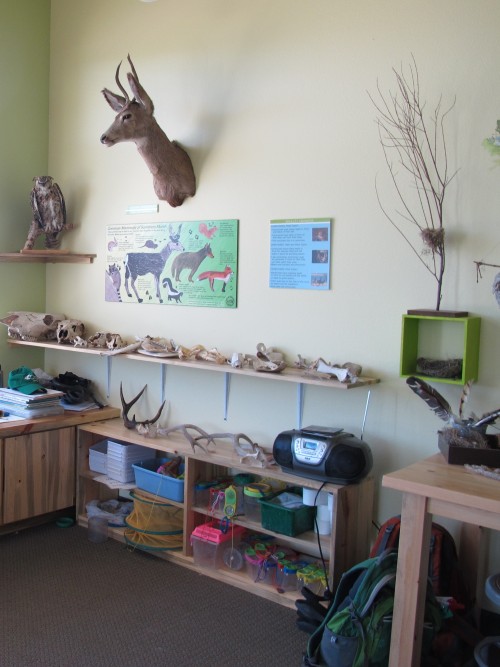 Found skulls and bones, as well as stuffed wildlife adorn several shelves and walls in the classroom.
Found skulls and bones, as well as stuffed wildlife adorn several shelves and walls in the classroom.
Upon arriving, I was given a flash drive on which years of Thorne’s curriculum was archived. I could use it, or create my own. I quickly decided it would be fun, as well as great experience, to come up with my own unique curriculum for the summer. Each week had a different theme (including: exploring our five senses, wetlands, pollinators, birds, and insects), which dictated the focus, but from there I could do whatever I wanted (within reason of course).
I had also landed myself in a new ecosystem. I come from the land of lush green plants (except for the month of August when we get our annual drought and the grass turns brown) and towering trees, where the most common colors of the sky are several different shades of gray and where we have about 15 different words to describe precipitation (it could be drizzling, misting, sprinkling, raining, a downpour, “snaining,”—which is different than “slushing” even though they both describe a rain-snow combination…).
So now here I was in a place with more brown than green, scraggly rather than lush vegetation, and temperatures that often rose to the mid-90s during the day and sank only to the low-80s at night. I’d been sweating it out all summer in my new “uniform” of a tank top and shorts and copious amounts of sunscreen applied at least 3 times a day, and then I heard one of my co-workers say that this has been a pretty cool, wet summer. And I thought, “Really?”
 The view from our lunch spot on a field trip to Walden Ponds. Thanks to these clouds it was a nice “cool” day of about 80 degrees.
The view from our lunch spot on a field trip to Walden Ponds. Thanks to these clouds it was a nice “cool” day of about 80 degrees.
Colorado gets most of its 17 inches of annual precipitation in the summer, coming in the form of sometimes daily afternoon thunder storms. The first time I experienced one of these storms, which started suddenly and unexpectedly while I was walking back up from downtown, I noticed that no one was outside. And those who were outside had stopped what they were doing to take shelter in doorways and under trees. I put my raincoat on and continued walking, wondering why no one else seemed to be prepared. And then I learned that people don’t know how to function in the rain here. I got questioned again and again by coworkers about how we Pacific Northwesterners get anything done and do we ever go outside? Then someone would say knowingly, “Yeah but they have so much coffee there,” and the others would nod, “Yeah, that must be it.” I would just smile shrug my shoulders and say “You just go outside when it rains. That’s what raingear is for.”
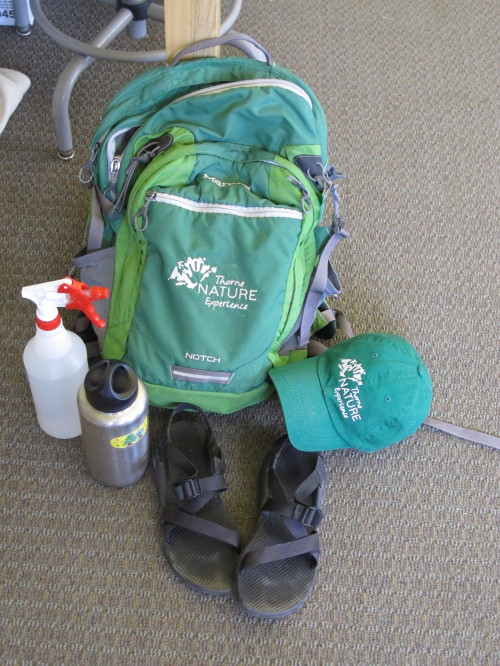 The essentials in my teaching backpack no longer require a raincoat and rain pants at all times! Here, my water bottle, hat, and spray bottle (to spray my students when they get too hot outside) are the most important.
The essentials in my teaching backpack no longer require a raincoat and rain pants at all times! Here, my water bottle, hat, and spray bottle (to spray my students when they get too hot outside) are the most important.
Now the summer is over. I’ve had some fun, I’ve learned a lot, I’ve gotten some great experience with a different organization and a different program. I’ve hiked up to 11,000 ft and realized that I can still breathe up there. I’ve gone from a bicycle-owner-who-doesn’t-actually-ride-their-bike to a bicycle commuter, racking up about 400 miles this summer. But it’s time to go home. My true home will always be in the gray, rainy northwest corner of the United States. Surrounded by enormous Western Redcedars and Douglas firs. Where my raingear never really dries all the way in the winter because I wear it so much and the air is so damp. Where we get mold in our houses. The Salish Sea and Puget Sound, the San Juan islands, the Pacific Ocean, the North Cascades. And now Mount Rainier where I’ll be part of the inaugural season of Mount Rainier Institute.
Leading photo: Along with the wetland the whole nature center sits on, there’s a small human-created pond where we look for insects, now that the parts of the marsh we can get to have dried up. It’s also a fun place to cool off your feet on a hot day. All photos by the author.
Ryan Weisberg is a graduate of North Cascades Institute and Western Washington University’s M.Ed. program. Ryan grew up here in Washington, exploring the natural areas around Bellingham and in the Cascades and feels most at home in the rain. Constantly finding themself picking up pen and paper, Ryan continues to enjoy writing for Chattermarks.


Thanks for alerting me to the Mount Rainier Institute.